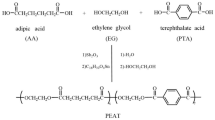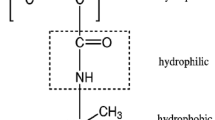Abstract
In this article, synthesis, characterization, and thermal properties of diacrylic/divinylbenzene copolymers based on the new aromatic tetrafunctional acrylate monomers are presented. The new monomers were generated by treatment of epoxides derived from various aromatic diols: naphthalene-2,3-diol (NAF), biphenyl-4,4′-diol (BIF), bis(4-hydroxyphenyl)methanone (BEP) or 4,4′-thiodiphenol (BES), and epichlorohydrin with acrylic acid. The addition reaction was carried out by a ratio of 0.5 mol of suitable epoxy derivative and 1 mol of acrylic acid in the presence of 0.7 wt% of triethylbenzylammonia chloride (TEBAC) as a catalyst and 0.045 wt% of hydroquinone as a polymerization inhibitor. The chemical structure of the prepared acrylate monomers was confirmed by 13C NMR and GC MS spectra. The emulsion–suspension polymerization of acrylate monomers with divinylbenzene (DVB) in the presence of pore-forming diluents (toluene + decan-1-ol) allowed obtaining microspheres containing pendant functional groups (hydroxyl groups). This process was carried out at constant mol ratio of acrylate monomers: DVB (1:1), and constant volume ratio of pore-forming diluents to monomers (1:1). The different concentrations of toluene in the mixture with decan-1-ol were used for qualifying the effect of the diluents on the microsphere characteristics. The influence of synthesis’s parameters on the properties of copolymer beads, e.g., pore size and surface area by BET method, the surface texture by AFM, swelling behavior in polar and non-polar solvents as well as thermal stability by differential scanning calorimetry (DSC), and thermogravimetric analysis (TG) was studied and discussed.





Similar content being viewed by others
References
Kotha A, Raman RC, Ponrathnam S, Shewale JG. Beaded reactive polymers, 1. Effect of synthesis variables on pore size and its distribution in beaded glycidyl methacrylate–divinylbenzene copolymers. React Funct Polym. 1996;28:227–33.
Chiu YY, Saito R, Lee LJ. Modification of unsaturated polyester resin for viscosity control. Polymer. 1996;37:2179–90.
Bicak N, Sherrington D. Mercury sorption by “non-functional” crosslinked polyacrylamides. React Funct Polym. 1995;27:155–61.
Ciesińska W, Zieliński J, Brzozowska T. Thermal treatment of pitch-polymer blends. J Therm Anal Calorim. 2008;95:193–6.
Ishizu K. Synthesis and structural ordering of core-shell polymer microspheres. Prog Polym Sci. 1998;23:1383–408.
Kawaguci H. Functional polymer microspheres. Prog Polym Sci. 2000;25:1171–210.
Zhang X-Z, Lewis PJ, Chu C-C. Fabrication and characterization of a smart drug delivery system: microsphere in hydrożel. Biomaterials. 2005;26:3299–309.
Xiao X, Zhuo R, Xu J, Chen L. Effects of reaction temperature and reaction time on positive thermosensivity of microspheres with poly(acrylamide)/poly(acrylic acid) IPN shells. Eur Polym J. 2006;42:473–8.
Stanek LG, Hellmann SM, Gleason WB. Preparation of monodisperse PMMA microspheres using 2-vinyl-4, 4′-dimethylazlactone as a spacer stabilizer. Colloid Polym Sci. 2006;284:586–95.
Luciani A, Coccoli V, Orsi S, Ambrosio L, Netti PA. PCL microspheres based functional scaffolds by bottom-up approach with predefined microstructural properties and release profiles. Biomaterials. 2008;29:4800–7.
Svec F, Fréchet JMJ. Temperature, a simple and efficient tool for the control of pore size distribution in macroporous polymers. Macromolecules. 1995;28:7580–2.
Sipos P, Szabo A, Erös I, Szabó-Rėwėsz P. A DSC and Raman spectroscopic study of microspheres prepared with polar cosolvents by different techniques. J Therm Anal Calorim. 2008;94:109–18.
Bisjak CP, Lubbad SH, Trojer L, Bonn GK. Novel monolithic poly(phenyl acrylate-co-1,4-phenylene diacrylate) capillary columns for biopolymer chromatography. J Chromatogr A. 2007;1147:46–52.
Rohr T, Knaus S, Sherrigton DC, Gruber H. Synthesis of sugar-containing hydrophilic porous polymer supports via suspension polymerization. Acta Polym. 1999;50:286–92.
Hradil J, Wojaczyńska M, Svec F, Kolarz BN. Sorption of phenols on macroporous methacrylate copolymers containing ethyleneamine groups. React Polym. 1986;4:277–83.
Narasimhaswamy T, Reddy BSR. Phenyl acrylates and divinylbenzene cross-linked copolymers as basic novel supports: synthesis and characterization. J Appl Polym Sci. 1991;43:1645–57.
Azanova VV, Hradil J. Sorption properties of macroporous and hypercrosslinked copolymers. React Funct Polym. 1999;41:163–75.
Smigol V, Svec F. Synthesis and properties of uniform beads based on macroporous copolymer glycidyl methacrylate-ethylene dimethacrylate: a way to improve separation media for HPLC. J Appl Polym Sci. 1992;46:1439–48.
Smigol V, Svec F. Preparation and properties of uniform beads based on macroporous glycidyl methacrylate-ethylene dimethacrylate copolymers: use of chain transfer agent for control of pore-size distribution. J Appl Polym Sci. 1993;48:2033–9.
Gawdzik B, Gawdzik J, Czerwińska-Bil U. Copolymer of di(methacryloyloxymethyl) naphthalene and divinylbenzene as a column packing for high-performance liquid chromatography. Chromatographia. 1988;26:399–407.
Gawdzik B, Osypiuk J. Reversed-phase high-performance liquid chromatography on porous copolymers of different chemical structure. J Chromatogr A. 2000;898:13–21.
Gawdzik B, Podkościelna B. An influence of diluent composition on the porous structure of 4,4′-diphenyl dimethacrylate–divinylbenzene copolymers. Ann UMCS. 2005;LX:282–95.
Gawdzik B, Podkościelna B, Bartnicki A. Synthesis, structure and properties of new methacrylic derivatives of naphthalene-2,3-diol. J Appl Polym Sci. 2006;102:1886–95.
Podkościelna B, Gawdzik B, Bartnicki A. Use of a new methacrylic monomer, 4, 4′-di(2-hydroxy-3-methacryloyloxypropoxy)benzophenone in the synthesis of porous microspheres. J Polym Sci A Polym Chem. 2006;44:7014–26.
Bukowska A, Bukowski W, Galina H, Sztycharz A. The kinetics of the reaction of methacrylic acid with Epidian 6. Polimery. 2000;45:109–12.
Mąkosza M. Synteza organiczna. Warsaw: PWN; 1972.
Worzakowska M. Thermal analysis of polyesters containing oxirane groups. J Therm Anal Calorim. 2008;93:799–803.
Worzakowska M. The influence of chemical modification of unsaturated polyesters on viscoelastic properties and thermal behavior of styrene copolymers. J Therm Anal Calorim. 2009;96:235–41.
Author information
Authors and Affiliations
Corresponding author
Rights and permissions
About this article
Cite this article
Podkościelna, B., Worzakowska, M. Synthesis, characterization, and thermal properties of diacrylic/divinylbenzene copolymers. J Therm Anal Calorim 101, 235–241 (2010). https://doi.org/10.1007/s10973-009-0574-6
Received:
Accepted:
Published:
Issue Date:
DOI: https://doi.org/10.1007/s10973-009-0574-6




